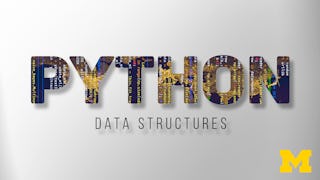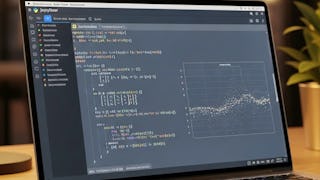In this course, you’ll explore data structures in Python, which are methods of storing and organizing data in a computer. You’ll focus on data structures that are among the most useful for data professionals: lists, tuples, dictionaries, sets, and arrays. You’ll also discover how to categorize data using data loading, cleaning, and binning. Lastly, you’ll learn about two of the most widely used and important Python tools for advanced data analysis: NumPy and pandas.

il reste 4 jours : Bénéficiez d'un coup de pouce pour le Black Friday avec 160 $ de réduction sur plus de 10 000 programmes.


Data Structures in Python
Ce cours fait partie de Spécialisation Google Data Analysis with Python

Instructeur : Google Career Certificates
Inclus avec
Ce que vous apprendrez
Use core NumPy and pandas data structures to store and organize data
Define Python tools such as libraries, packages, modules, and global variables
Describe the main features and methods of built-in Python data structures such as lists, tuples, dictionaries, and sets
Compétences que vous acquerrez
- Catégorie : Data Import/Export
- Catégorie : Data Wrangling
Détails à connaître

Ajouter à votre profil LinkedIn
septembre 2025
5 devoirs
Découvrez comment les employés des entreprises prestigieuses maîtrisent des compétences recherchées

Élaborez votre expertise du sujet
- Apprenez de nouveaux concepts auprès d'experts du secteur
- Acquérez une compréhension de base d'un sujet ou d'un outil
- Développez des compétences professionnelles avec des projets pratiques
- Obtenez un certificat professionnel partageable

Il y a 5 modules dans ce cours
In this module, you will explore data structures in Python, which are methods of storing and organizing data in a computer. You’ll focus on lists and tuples, data structures that are among the most useful for data professionals.
Inclus
5 vidéos3 lectures1 devoir3 laboratoires non notés
In this module, you will focus on dictionaries and sets, some more data structures that are among the most useful for data professionals.
Inclus
3 vidéos2 lectures1 devoir2 laboratoires non notés
In this module, you will focus on arrays. You’ll learn about one of the most widely used and important Python tools for advanced data analysis: NumPy.
Inclus
3 vidéos3 lectures1 devoir2 laboratoires non notés
In this module, you will learn about one of the most widely used and important Python tools for advanced data analysis: pandas. You’ll also discover how to categorize data using data loading, cleaning, and binning.
Inclus
5 vidéos3 lectures1 devoir2 laboratoires non notés
Review everything you’ve learned and take the final assessment.
Inclus
1 lecture1 devoir
Obtenez un certificat professionnel
Ajoutez ce titre à votre profil LinkedIn, à votre curriculum vitae ou à votre CV. Partagez-le sur les médias sociaux et dans votre évaluation des performances.
Instructeur

Offert par
En savoir plus sur Data Analysis
 Statut : Essai gratuit
Statut : Essai gratuitUniversity of Michigan
 Statut : Essai gratuit
Statut : Essai gratuitUniversity of Colorado Boulder
 Statut : Essai gratuit
Statut : Essai gratuit
Pour quelles raisons les étudiants sur Coursera nous choisissent-ils pour leur carrière ?





Ouvrez de nouvelles portes avec Coursera Plus
Accès illimité à 10,000+ cours de niveau international, projets pratiques et programmes de certification prêts à l'emploi - tous inclus dans votre abonnement.
Faites progresser votre carrière avec un diplôme en ligne
Obtenez un diplôme auprès d’universités de renommée mondiale - 100 % en ligne
Rejoignez plus de 3 400 entreprises mondiales qui ont choisi Coursera pour les affaires
Améliorez les compétences de vos employés pour exceller dans l’économie numérique
Foire Aux Questions
Organizations of all types and sizes have business processes that generate massive volumes of data. Every moment, all sorts of information gets created by computers, the internet, phones, texts, streaming video, photographs, sensors, and much more. In the global digital landscape, data is increasingly imprecise, chaotic, and unstructured. As the speed and variety of data increases exponentially, organizations are struggling to keep pace.
Data science is part of a field of study that uses raw data to create new ways of modeling and understanding the unknown. To gain insights, businesses rely on data professionals to acquire, organize, and interpret data, which helps inform internal projects and processes. Data scientists rely on a combination of critical skills, including statistics, scientific methods, data analysis, and artificial intelligence.
A data professional is a term used to describe any individual who works with data and/or has data skills. At a minimum, a data professional is capable of exploring, cleaning, selecting, analyzing, and visualizing data. They may also be comfortable with writing code and have some familiarity with the techniques used by statisticians and machine learning engineers, including building models, developing algorithmic thinking, and building machine learning models.
Data professionals are responsible for collecting, analyzing, and interpreting large amounts of data within a variety of different organizations. The role of a data professional is defined differently across companies. Generally speaking, data professionals possess technical and strategic capabilities that require more advanced analytical skills such as data manipulation, experimental design, predictive modeling, and machine learning. They perform a variety of tasks related to gathering, structuring, interpreting, monitoring, and reporting data in accessible formats, enabling stakeholders to understand and use data effectively. Ultimately, the work of data professionals helps organizations make informed, ethical decisions.
Large volumes of data — and the technology needed to manage and analyze it — are becoming increasingly accessible. Because of this, there has been a surge in career opportunities for people who can tell stories using data, such as senior data analysts and data scientists. These professionals collect, analyze, and interpret large amounts of data within a variety of different organizations. Their responsibilities require advanced analytical skills such as data manipulation, experimental design, predictive modeling, and machine learning.
Plus de questions
Aide financière disponible,


